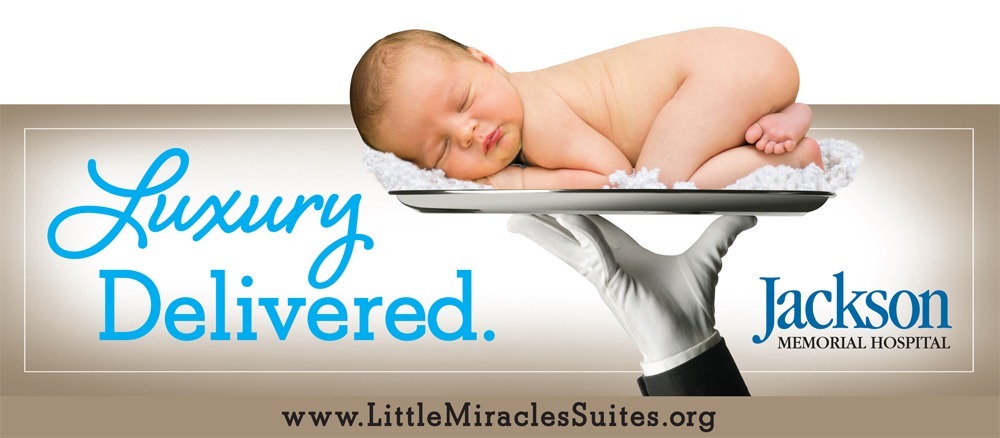Should You Sell Your Maternity Services Like a Resort?
For One Florida Hospital, It Was the Smart Way Out of a Marketing Conundrum.
Notable Health Care Advertising
// By Peter Hochstein //
 For people trying to market the maternity services at Jackson Memorial Hospital, a huge institution in Miami, Florida, with more than 1,254 beds on its main campus alone, it must have felt like the best of times and the worst of times.
For people trying to market the maternity services at Jackson Memorial Hospital, a huge institution in Miami, Florida, with more than 1,254 beds on its main campus alone, it must have felt like the best of times and the worst of times.
It was the best of times because the hospital, once teetering on the edge of financial failure, had regained its equilibrium under the leadership of a new president and CEO, Carlos Migoya, a charismatic local banker. In just a few years, he had brought the hospital from a $400 million deficit to a $50 million surplus.
It was also the best of times because, as quantitative market research made clear, the hospital had a powerful reputation for medical expertise, despite its former financial troubles. It was, and still is, a teaching hospital with a Level 1 trauma center.

Matthew I. Pinzur, Associate Vice President, Communications and Outreach at Jackson Memorial Hospital
But there was a catch. Perceptions were strong, says Matthew I. Pinzur, Associate Vice President, Communications and Outreach at the hospital, “that the facilities were outdated, not large, not up to modern standards.”
That negative perception was particularly relevant to maternity services. As Pinzur explains it, “When you’re talking about organ transplants, the quality of the room you’re staying in is not one of the top three concerns.” But with maternity, he says, most people think they’re going to have a routine experience.
“That makes the accommodations much more important on the front end when they’re deciding which hospital even to consider. So we felt it was valuable to marry the idea of the medical miracles we do here with the luxury that we can produce,” he says.The result was the Little Miracles Maternity Suites, heralded with an advertising campaign created by The Weinbach Group, also of Miami. Daniel Weinbach, the ad agency’s President and CEO, says the campaign also indirectly addressed the fact that as “the only public hospital in Miami Dade County, it was charged with caring for the poor and indigent.”
Consequently, he says, in an area with many competing hospitals, “If you had a normal pregnancy without complication, there had to be an impetus to go downtown to Jackson, rather than to your nearby hospital.”
The impetus that The Weinbach Group created was an image of the hospital’s newly upgraded maternity suite, which is all about luxury and pampering. In a 30-second television spot, the camera presents images that begin with shots of billowing sheets, fluffy blankets, and a pair of pristine white towels, rolled up to look like swans. It progresses to appetizing food shots, a close-up of cosmetics, and a woman wearing a sleep mask. There’s no picture of a baby until halfway into the spot. In a way, this spot isn’t even about babies. It’s about the experience for mothers. That’s rare in a field where maternity services pretty much start on babies in frame one and keep the lens on them until the closing title.
Voiceover announcer copy makes it clear that the imagery is no accident. It begins, “There’s a place where every woman gets pampered. Where comfort is the top priority. And where no detail is overlooked. You might think it’s a luxury hotel. Or maybe a fancy spa. It’s actually the Little Miracles Maternity Suites …”
The campaign launched in March 2015 and is still running in flights on broadcast and cable stations in the Miami area. The media buys are made on programming that attracts women 18 to 35 years old. Among the media buys, “Late night has proved to be surprisingly efficient,” Weinbach says.
The media budget was “between half a million and a million dollars,” according to Pinzur, and helps Jackson Memorial compete with “approximately 22 private hospitals that together have more than 6,000 beds.”
Miami’s population is heavily multicultural, so “we always approach our creative mindful of the diversity of this market,” Weinbach says. Parallel spots were cast and then shot simultaneously for Spanish-speaking and African-American consumers, with special attention paid to using “dialectically neutral” language for the Spanish-language versions because, “Cubans talk differently than Colombians, who talk differently than Venezuelans.”
Print is used sparingly, but outdoor advertising is a significant factor. The agency puts its client’s media money into billboards on surface streets rather than highways. Advertisers with less well-known positioning and messages can do better on slow streets, Weinbach believes, because “it’s difficult to absorb those at 70 miles per hour,” he says.
One of the billboards showing a baby sleeping on a silver platter held by a white gloved hand “was the source of a lot of buzz,” Weinbach says. But Pinzur puts up a strong defense to critics of the ad: “My response was always, ‘If it’s getting noticed, it’s doing its job.’”

Conversation starter: While showing a baby sleeping on a silver platter, supported by a white-gloved hand, was meant to suggest luxury, it also discomforted a few critics. Pinzur defends it, saying the image prompted awareness.
And the entire campaign certainly got noticed. By last December, visits to the Little Miracles landing pages had grown to an average of 2,100 per week from 135 per week when the campaign began, says Pinzur. He adds that the average has spiked as high as 2,168 per week.
Perhaps more important, downloads of a PDF brochure about amenities in the Little Miracles facility, a likely indication of both need and interest, have been as high as 327 per week. The hospital also gets more than 20 requests per week for tours of the facility, and actual volume is up from 6,028 in the 2012 fiscal year to a projected 7,500 for the current fiscal year.
Marketing tips from Pinzur and Weinbach
Hire smart: “Surround yourself with people who are smarter than you are,” Pinzur says. Pinzur, who joined Jackson Memorial after working as a journalist and then as a policy analyst for the local county manager, says, “The only person who’ll admit they don’t know much about marketing is me.” He adds, “I am extremely fortunate to have a team of people who are creative, who are thoughtful, and who understand the traditional way of approaching [hospital marketing] and when you need to upturn the traditional way of approaching it.”
Consumers aren’t waiting for you with eager anticipation: “It can be easy to fall into the trap of forgetting … and to think everyone in your market is comparing quality scores among all the hospitals in the marketplace,” Pinzur warns. “The reality is, most don’t think about you or your competitors at all until they need to go to the hospital.”
Focus on customer needs: Simply doing the same kind of advertising other hospitals do “doesn’t mean it’s a good move,” says Weinbach. “Sameness cannot differentiate a hospital. One example is those ubiquitous ER wait time billboards.” Instead, he says, “Identify what your health care customers want and explain how your organization can deliver it, whether that’s a comfortable hospital room, pain relief, or a faster recovery.”
Peter Hochstein is a direct response advertising consultant, business journalist, and author. He is the author of “Lessons from 9 Innovative Health Care Marketing Campaigns,” a white paper you can download for free. You can reach him through his website, http://peterhochstein.com.

